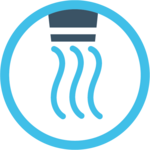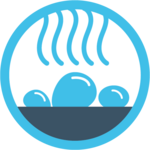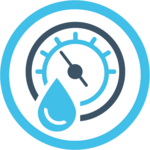de
en
- Industrial Cleaning
- Sheet Metal Technology
- Silberhorn Group
- News
- Career
- Substainability
- Contact
What methods do you use to clean industrial components? How do you remove (Flitter) burrs, oils, greases and lubricants? How can a component become so clean that is undergo further processing or machining? We at Silberhorn have the answer.
Depending on the components and the cleanliness requirements, you need a certain cleaning machine, a combination of cleaning and drying methods or processes determined specially for you, and an appropriate cleaning chemical. We work out all this jointly with you in various (laboratory) analyses – your cleaning machine is then created based on these.
We describe the cleaning and drying processes or methods that can be used at Silberhorn for you on this page in our glossary:
Water is ejected out of a nozzle and is aimed with high kinetic energy on the component, thus removing the dirt or contamination. Generally, pressure between 3 and 8 bar is used for cleaning, although up to 60 bar would be feasible. Depending on the geometry, the nozzles influence the cleaning behaviour, with the angle of the jet, impact angle and drop size being crucial for the outcome.
Moreover, the alignment of the nozzles to the component plays an important role. In doing so, relative movement may be necessary – like that of blind holes or undercuts. This means that either the component, the nozzle or both component and nozzle move.
Spray cleaning is ideal for less complex components or for cleanliness requirements in the standard or default range. Spray cleaning is used, for example, in chamber cleaning systems (e.g. MWS). It is installed only rarely even in Silberhorn robotic cells (REZ).

High-pressure cleaning is used primarily for deburring. It loosens, for example, stubborn shavings in bore holes, so-called jammed or stuck shavings. It is used where other processes encounter technical or economic limitations. The water jet impinges optionally on the component either in a targeted manner or non-targeted manner during high-pressure cleaning. This high level of kinetic energy leads to loosening or releasing the burrs.
In principle, this method is also spray cleaning – however, the liquids impinge with far higher speed and considerably more pressure on the component. How high the pressure may be is machine-dependent. With Silberhorn, generally up to 1500 bar is available in the robotic cell REZ 1-3. Separately developed robotic cells (RSZ) apply up to 1800 bar on the component, wherein Silberhorn has made even 2500 bar possible in specific cases. However, these are extreme exceptions that need very high levels of energy.
Apart from the respective machine variant, the material also imposes clear restrictions on the pressure: Aluminium tolerates about 300 to 400 bar maximum, (Steel) cast parts up to 600 bar, steel parts get damaged with about 900 bar and stainless steel tolerates up to 1500 bar. High-pressure cleaning is used at Silberhorn in the REZ already mentioned, in rotary table machines (HP range), in the continuous cleaning machine MultiLine (S range with HP) and in the machines manufacturer especially according to customer's requirements.

Pressure flooding is the method of choice for stubborn contamination levels, with full cleaning cages and for complex components, whose interior spaces, bore holes or undercuts that are often only difficult to reach or not at all accessible by spray cleaning. In case of pressure flooding, the component is immersed along with the gripper or carrier in a bath with the cleaning liquid (water + chemical). Several nozzles in the basin generate rigorous turbulence (“conveyance flow”) with high level of kinetic energy (values of pressure up to 40 bar). Thanks to this whirlpool effect, even hollow spaces are cleaned perfectly.

This is a method that is used in chamber cleaning machines, for example, such as the MWS. The cleaning chamber is filled up to half with cleaning liquid. Similar to pressure flood cleaning, here too, several nozzles provide turbulence and thus, plenty of energy in the basin. However, in the case of retention flooding, the component is immersed time and again, and then taken out of the bath – similar to cleaning a carafe by hand. In this way, the cleaning liquid runs into the component and again out of it with every revolution of the cage. Particles of dirt or contamination are washed out. For components with complex geometries and stringent cleaning requirements.

In special immersion systems, the component is dipped into a basin with cleaning liquid. Impurities such as oils, greases or metallic shavings are dissolved by the chemical effect. Simultaneously, the component is moved mechanically – that enhances the effect of cleaning. Frequently, other methods are also used as supporting methods, for example, ultrasonic cleaning or pressure flood cleaning. This is an ideal method for cleaning individual parts or components, bulk goods and items placed in cages.
The component is immersed in a basin with cleaning liquid (water + cleaning chemical). The ultrasonic waves are guided through the basin by so-called ultrasonic oscillators. The cavitation effect is created: Steam bubbles are formed on the surface of the component, which again collapse (implode) and thus, loosen or release the dirt. In doing so, the cavitation effect depends on the energy (amplitude), frequency of the ultrasonic waves, and the duration of the ultrasonic process. All these parameters are matched exactly to your component.

The preservative is applied to the component during the dipping or spraying process to avoid rust formation. Depending on the preservative and process used, rust protection can be guaranteed for up to 2 years. This method is ideal for components made from steel or cast iron.
For standard requirements of the dryness of the components, you can use targeted drying with the help of compressed air pulses.

Hot air is excellent for supporting the drying process. This method is already good for stringent requirements. The principle is easy and – speaking in simple terms – comparable with a hair dryer.

Compressed air pulse drying divide the drops adhering to the surface of the component into several small drops. As a result of total surface area enlarged in this way, the hot air blown in evaporates the moisture in far less time. This reduces the drying times considerably.

Generally, depending on the parts to be cleaned and the maximum quantity of parts, the optimal drying time is obtained and programmed. Next, the drying program – regardless of the loading – always runs for the same period of time. The drying becomes intelligent with the moisture measurement: During hot air drying, a sensor continuously checks the moisture in the air in the circulating air flow. The system knows, thanks to the component-specific analyses carried out earlier, the value of residual moisture in the air from which the components are dry. If the defined value is undershot, the Silberhorn cleaning system terminates the drying process immediately.
Thus, Silberhorn cleaning machines perform drying depending on the component and loading for different periods of time. This saves, time, valuable resources and thus, money.

The air pressure in one chamber is lowered to less than 10 mbar. This is when the liquids boil and vaporize right from a temperature of 50˚ C. In this way, drying processes get accelerated considerably and cycle times get reduced. This method is recommended primarily for components with bore holes, hollow spaces or equivalent and meets the most stringent requirements of dryness.
